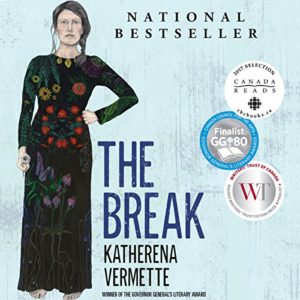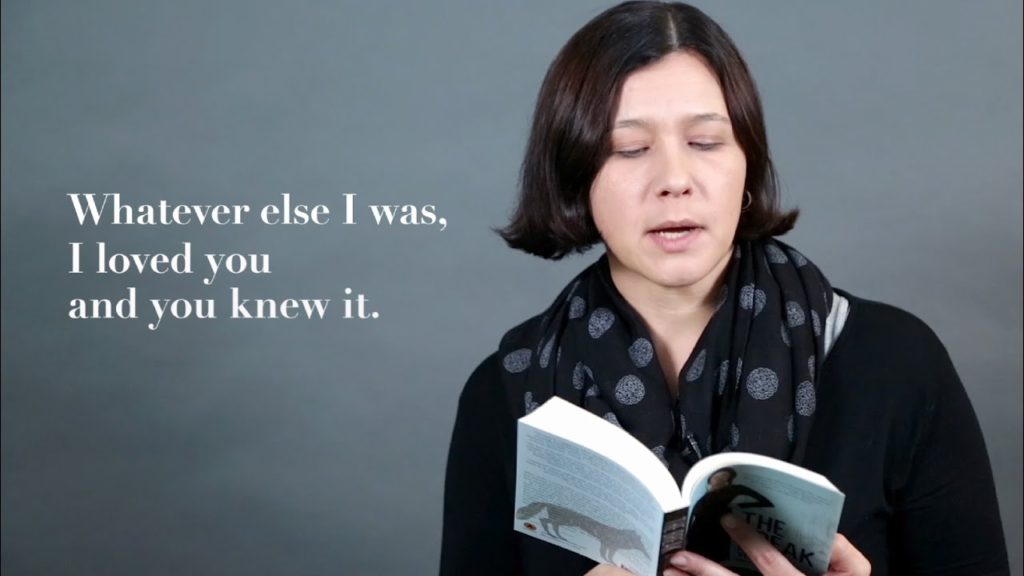
Credit to Amazon.ca for this image, and for choosing The Break for their Best First Novel Award — but buying from a local bricks’n’mortar bookstore is a virtue.
[7-minute read]
I grew up next to the Six Nations of the Grand River, played hockey and ball with guys off the Rez and then came high school. All the “upper-ender” kids came to Caledonia High School, so I was in class with them and added Native teammates and friends via football and basketball. (Phys. Ed. efforts with the webbed stick told me I was way too far behind to even try to play lacrosse with the Porters and Logans and Thomases.) Had we known the term, I might have described myself as “woke” when it came to an understanding of, and empathy and affection for, Indigenous people. I would have been wrong, of course.
Travelling across Canada after graduation, I got off a bus at the Winnipeg terminal in 1977 and didn’t know where I was. This is Canada? I was 19. My tenderfoot experience hadn’t prepared me: this was an assault to the senses and my small-town sensibilities, a sudden exposure to realities that most non-Indigenous Canucks, more or less actively, ignore or suppress. At the simplest level, it was the first time in my life where *I* was the ethnic minority, and my skin tone also made me (or my pockets, which were far from deep at the time) a target for desperate panhandlers. It was a pathetic carnival of faces ravaged by addiction, poverty, listlessness, need and other forms of oppression. My first grim sight of Winnipeg looked like a war zone, minus the helmets and artillery.
I was a young white Canadian. I had a lot to learn.
I still do.
Katherena Vermette’s The Break, set in Winnipeg’s North End, could be called my most recent bit of instruction if that didn’t insult the art of the thing. I was a little slow to that party, too, three years after this startlingly strong first novel made a national splash on Canada Reads. (Disclosure: three years late in getting to a novel is pretty good for me. Though a CBC Radio devotee, a part-time lit-wit and former English Creature, I haven’t paid sufficient attention to CR, and now, like so much of what we took for granted, it’s semi-cancelled.) But that makes it a perfect candidate for my Better Read Than Never series. Hurray.
The Old Smiling White Guys Book Club (not its real name) that I tag along with has been a delight. It pushes us to read fiction that stretches and challenges us, and the conversations have been, well, thrilling is not too strong a word. (I was so hungry.) We’re about a year in, and I think it was January’s conclave where one of us reported that he was being sweetly goaded by his partner: Where are the women on your list? Where are the writers of colour? The group responded with a bravery and openness that are characteristic. At the same meeting where we gulped, sat up straight and agreed to an extra meeting where we’d open the door to POETRY, fer gawd’s sake, we also agreed that our next novel would be The Break. We all knew about it, all felt it was something we really should’ve gotten to in the Age of Reconciliation, but none of us had. So: March. Let’s give ourselves a shake.
Well, *I* was shaken, before I even cracked the cover. I was visiting a dear buddy, someone who has found, for many years now, a wonderful sense of community and spiritual consolation in exploring the Anishinaabe (Mississaugas) part of his heritage. He is battling a rare cancer now. We sat in his den, catching up with each other. He explained his treatment protocols. He listed all the support that sustained him. He showed me the stack of textual nourishment on his coffee table.
“Hey! K, I’ve been looking for The Break. You finished with it?”
He wasn’t. He couldn’t continue, even though the bookmark sat at page 272. “It’s not that it’s not well done. She’s really good. It’s just, ah, it’s too hard.” I was amazed. He could put down a novel he’d invested in deeply, that he was, what, 50 or 60 pages from completing? That’s some pain.
Katherena Vermette brings the pain. The Break delivers a rich set of characters and a fine ear for dialogue, and descriptions that confirm she’s a poet, and a fine one (her first book was a collection called North End Love Songs, which won the Governor General’s Award for poetry). But it’s harrowing. We begin inside the experience of a traumatized witness to horrific violence, an event that we are allowed to approach only obliquely, in an indirect, suggestive yet suspensefully brooding series of narratives. Stella – we won’t know how she fits into the rest of the story, and with the eight other narrative points of view in the novel, until we’re about halfway through — is a 20-something Métis woman. She first tells us about The Break, a strip of land beside her home in north-end Winnipeg with frozen-in-mid-stride “robots” (her young son’s name for the electrical towers that span it) and a seemingly eternal cover of deep snow. Vermette’s title, then, is a nod to her geographical roots in “Treaty 1 territory”, but it comes to suggest many things.
Alongside the vivid struggles of most of the main characters, Vermette’s impressionistic layering of chapter upon chapter presents another challenge for the reader. She’s not trying to make it easy for us. (Early on, I bookmarked the extended family tree that precedes the first chapter, and I consulted it regularly for the first 150 pages.) Each chapter is titled with the name of the person whose consciousness we are exposed to, and the story unspools in these narrative puzzle pieces. Just as we get a preliminary sense for who Louisa is, or Paul or Cheryl or Phoenix (“wait, what’s she got to do with this?”), and what role each plays in the larger story, we move on to what another character sees and thinks. (All but one of these named characters is explored from a 3rd-person point of view; Louisa’s is a first-person telling, as is that of a mysterious unnamed voice which opens each of the novel’s four parts.

Vermette reading from The Break. Superimposed is a snippet of the mystery voice that recurs in each part of the novel. (YouTube image)
Only in the last third of The Break do we realize how simple the plot actually is, and how little time has elapsed. The richness of the novel is in the gradually rendered collage of each character’s looks backwards. Where does she come from, geographically and culturally but especially in terms of family relations? (Only one of the characters we know from the inside is male; Tommy is a rookie cop on the hunt for the perpetrators of the central act of violence, but also increasingly to understand his own family history.) How did she get here? And where are the men? Two sisters, Cheryl and Lorraine, are at the relationship core of the novel. Their mother and their daughters each have lived – with only one exception — with the comings and goings (or the outright absence) of their menfolk. Aside from officer Tommy and his rather cartoonish veteran partner, the other men are shadowy and often suspicious presences. (Perhaps Vermetter would agree with Margaret Atwood: asked at a reading why “your men aren’t stronger”, Atwood drawled, “Perhaps that question would be better taken up with God.”) The novel is definitely and unapologetically about women, in fact about Indigenous women in one section of Winnipeg (a Cree term meaning “muddy waters”, I was intrigued to discover), and it’s the oldest truth in literature: tales of the intensely local, well told and filled with characters we know and care about, become universal.
So can a certified Guy in a Guy’s Book Club enjoy Vermette? The short answer is “of course he can, if he tries!”, although “enjoy” is a sticky verb. The novel is well worth the work that a reader needs to put into it, and I’m grateful for the variety of ways I was nudged to read it. It took me some time to establish a rhythm that worked for me as a reader. Too many chapters in one sitting (initially, any more than one), and I’d feel not only the confusion of who was whom but also a sense that I wasn’t properly hearing and distinguishing each chapter’s central voice. Read too little, though, or with too many hours in between, and I’d lose my perspective on the gradually focusing family portrait that Vermette sketches. I’d lose the deepening chill of really seeing what has happened to these people. It’s the old literary truism: the book taught me how to read it. At times the spiral of suffering and bigotry and generational dysfunction was oppressive to read. How could it not be? (And a little vicarious oppression can’t hurt!) But Vermette almost never slips into explaining or lecturing about historic injustices to Indigenous peoples. She shows us her characters; we listen to them. (Again, the dialogue rings genuine. I was fascinated at the clear correspondences I heard between her Manitoba Métis characters and the voices of Six Nations people thousands of kilometres east and south.) As uncomfortable as it sometimes is, we live in the skin, the sorrows and accidents, the delights and decisions of these women. I still wonder, as I do for my former students and players I’ve coached, what becomes of these people. What will happen for Emily? For Stella? For…?
I wasn’t far into The Break before I understood better why my friend K hadn’t finished it, and I realized that his final bookmark coincided with a particularly grim unveiling of a shocking act of violence. I’ve sent it back to him now that I’ve finished. And no, there is no sudden reversal of polarity; there is no improbably sunny ending. Vermette’s tying up of the many narrative threads of the story is neither neat nor complete, but neither is it as bleak as K (and I) had been dreading. I recommended to K that he finish it, and I strongly suggest, even if (or especially if) you are non-Indigenous and/or male, that you should crack open the Break. Katherena Vermette is a writer whose career I will follow¹.
